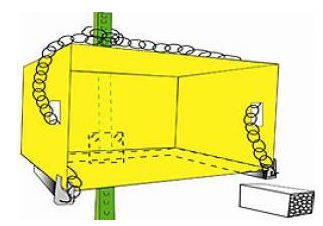
Features
Production
Research
Need bees? Plastic totes make superb bee nursery
April 14, 2009 By USDA Agricultural Research Service
 April 10, 2009 — Corrugated plastic bins, like the kind sold for
April 10, 2009 — Corrugated plastic bins, like the kind sold for
handling mail and packages, can be quickly and easily converted into a
durable nursery for wild bees, according to an U.S. Department of
Agriculture (USDA) Agricultural Research Service (ARS) research
entomologist.
April 10, 2009 — Corrugated plastic bins, like the kind sold for handling mail and packages, can be quickly and easily converted into a durable nursery for wild bees, according to an U.S. Department of Agriculture (USDA) Agricultural Research Service (ARS) research entomologist.
 |
| Drawing of nesting shelter for some wild bee species. Corrugated plastic totes can be converted into convenient nesting shelters for several wild bee species. (Drawing courtesy of Ellen M. Klomps, ARS) |
James H. Cane, with the agency’s Pollinating Insects Biology, Management and Systematics Research Unit in Logan, Utah, says that female wild bees will readily use a properly placed, suitably furnished tote as a shelter for their nests. Turned on their long side, the totes can be held firmly in place on a wooden or metal post by means of a lightweight steel chain and a customized metal support frame.
Cane came up with the idea of using corrugated plastic totes — available from suppliers of mail and package handling equipment — as nesting shelters, and has tested them during spring and summer in California, Oregon, Wyoming and Utah. His experiments show that the lightweight, rectangular bins – each 23.5 inches long by 15.5 inches wide by 15.5 inches high – serve as a sturdy, inexpensive and reusable shelter for protecting bee nests against wind and rain.
Growers, professional and hobbyist beekeepers, and backyard gardeners who want wild bees to live near and work in their fields, orchards, vineyards or home gardens can use the totes to house nesting materials, such as five-sixteenths-inch diameter paper drinking straws enclosed in cardboard tubes and stuffed inside empty cardboard milk cartons. Wild female bees such as the blue orchard bee, Osmia lignaria, can use the straws as homes for a new generation of pollinators.
Wild bees are needed now, perhaps more than ever, to help with jobs usually handled by North America’s premier pollinator, the European honey bee, Apis mellifera. Many honey bee colonies have been decimated by colony collapse disorder or weakened by varroa and tracheal mites or the microbes that cause diseases such as chalkbrood and foulbrood.
A single corrugated plastic tote can accommodate as many as 3,000 young, enough to pollinate one-half to one-acre of orchard. And, unlike bulky or stationary shelters, the tote houses can easily be moved from one site to the next.
Corporate collaborator Quiedan Co., of Salinas, Calif., helped design and now sells the support frame and mounting plate unit.
Cane published the shelter research for the first time in a July 2006 article in American Bee Journal. The totes are now being used in California and for Cane’s own research in Oregon.
CUTLINE
Drawing of nesting shelter for some wild bee species. Corrugated plastic totes can be converted into convenient nesting shelters for several wild bee species. Nesting materials encased in milk cartons (lower right) can be stacked in the tote for female bees to use as homes for a new generation of pollinators. (Drawing courtesy of Ellen M. Klomps, ARS)
Print this page